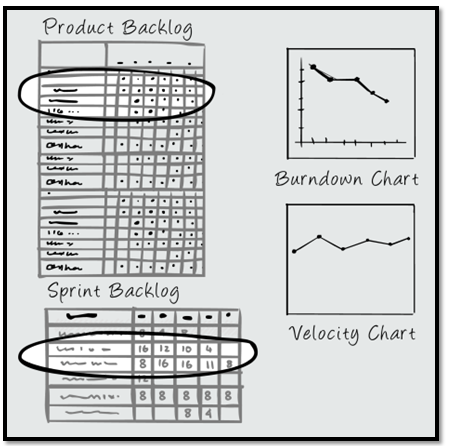Planning and Coordinating use Agile PPM tools
Executives are responsible for maintaining the structure of the organization and supporting the mechanisms that enable the flow of value across many teams. To that, executives should plan and coordinate across major organizational domains. Though I believe there are eight domains which executives should be planning and coordinating in, I'm not prepared to say Sales & CRM or Marketing Management should be included in an Agile PPM tool (at this time). Beyond that, a single PPM tool should cover the remaining six domains.
Often, the first tools purchased are to help the delivery teams manage their daily work. As the organization evolves or grows, more tools are purchased to cover the gaps left by the team-level tools. The tools then become entrenched. At some point, organizations have a collection of tools they are trying to maintain and they lose sight of the original reasons for purchasing and implementing them.
Organizations then turn to PPM tools. There is a wide variety of motivations for using agile project portfolio management (PPM) tools. One key reason can simply be the desire for their teams to collaboratively plan. Other key reasons include the desire to prioritize and track work on a synchronized cadence, while providing visibility of the portfolio to the executive stakeholders. To meet organizational needs, the number of tools being used to satisfy these desires expand over time.
Before you choose an Agile PPM tool, remember that your company operations should influence how that tool is implemented across your organization, not the other way around.
What types of problems are Agile PPM tools good at solving?
Six Organizational Domains of Planning and Coordinating
Portfolio Management
The art and science of making decisions about investment mix and policy, matching investments to objectives and key results (OKRs), asset allocation for individuals and institutions, and balancing risk against performance. Your Agile PPM tool needs to provide a sufficient level of visibility of the roadmap and investment themes, through the lens of a portfolio team.
Program Management
The process of managing several related projects or products that are part of an investment portfolio. Your Agile PPM tool must provide a sufficient level of visibility of the release backlog and to allow for necessary elaboration for release targeting, all through the lens of a program or capability team.
Capacity Management
Deals with the organizations ability to create or develop new product. Capacity constraints in any process or resource can be a major bottleneck for a company. Your Agile PPM tool should make it easy to know what the organization and teams have historically delivered, in order to understand where the bottlenecks exist, and what to commit to in the future.
Human Capital Management
Related to people resource management. In order to deliver product predictably, it is necessary to have stable teams, providing specific competencies. Your organization needs the right people in place to deliver on commitments in the portfolio. Do you need to hire or replace people? Your Agile PPM tool should help facilitate a conversation around who are the right people, what teams they should be on, and when we need them on a team.
Dependency Management
The ability to either encapsulate or orchestrate around “dependent” organizational, structural, or technical activities. Dependencies tend to be a major productivity killer for organizations. They slow and sometimes stop the ability to deliver value. It is critical that your Agile PPM tool provides indications of dependencies across the organization. Having the first indication of a dependency discovered after a delivery team has already made a commitment against its impacted deliverable is too late.
Budget Management
Refers to a financial plan for a defined period of time. It may also include planned revenues, resource quantities, costs and expenses, assets, liabilities and cash flows. Your Agile PPM tool must provide the necessary information to shift conversations from just scope and schedule to budget.
Summary
Use the above list as a guide to catalog tools your organization is using (or considering) for planning and coordinating. Are there gaps or are there overlaps and duplications? If you have overlaps and duplications, there is an opportunity for you to consolidate some of those tools. Begin consolidating tools, and you may reclaim some budget next year you didn't think you had.
Want to know how you are covering the six or eight domains? Schedule an assessment with me.


 Over the last few years, I've worked with numerous teams. One thing they all struggle with is backlog grooming. They all know they need to do it. Unfortunately, they all seem to struggle with when to do it or who should do it. The most interesting struggle with backlog grooming happened two years ago. The "story time" meetings took place at the beginning of a month-long sprint. The manager stated, the work to be completed and delivered during that sprint had to be refined within the same sprint. This helped explain why the team thought they needed month-long sprints. When I asked why they would try to refine work the first two weeks of the sprint and then complete that work the second two weeks, you know what their answer was? "It said to do it like that in the Scrum Guide!" After I clarified their misunderstanding, we established a cadence to continuously mature the backlog. A rotating selection of people would participate in the scheduled meetings. We would reserve capacity from each sprint to get that work ready for future sprints. The team was able to shorten their sprints to 2 weeks. They more than doubled their delivery rate without increasing defect rates. With that as an example, over the last few years, I have evolved my practice of backlog grooming. Let’s look at some key dates in the evolution of backlog grooming.
Over the last few years, I've worked with numerous teams. One thing they all struggle with is backlog grooming. They all know they need to do it. Unfortunately, they all seem to struggle with when to do it or who should do it. The most interesting struggle with backlog grooming happened two years ago. The "story time" meetings took place at the beginning of a month-long sprint. The manager stated, the work to be completed and delivered during that sprint had to be refined within the same sprint. This helped explain why the team thought they needed month-long sprints. When I asked why they would try to refine work the first two weeks of the sprint and then complete that work the second two weeks, you know what their answer was? "It said to do it like that in the Scrum Guide!" After I clarified their misunderstanding, we established a cadence to continuously mature the backlog. A rotating selection of people would participate in the scheduled meetings. We would reserve capacity from each sprint to get that work ready for future sprints. The team was able to shorten their sprints to 2 weeks. They more than doubled their delivery rate without increasing defect rates. With that as an example, over the last few years, I have evolved my practice of backlog grooming. Let’s look at some key dates in the evolution of backlog grooming.




